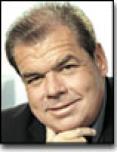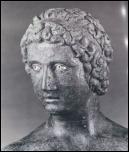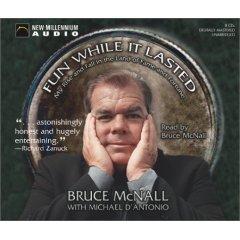Mazur: Hecht's Partner On The Roman Bronze Boy
Bruce McNall, Former Hecht Partner, On The
Roman Bronze Boy
By Suzan Mazur


Bruce McNall & a head shot of the Roman Bronze Boy
"Where's Bruce McNall?" It was the question on everyone's lips at the June 1990 Sotheby's auction in New York of the Hunt antiquities, which McNall had sold to brothers Bunker and Herbert -- and again in November at the New York Hesperia Arts sale. The Hesperia auction liquidated Bruce McNall's and Bob Hecht's Rodeo Drive Summa Gallery antiquities stock. The major players feasted, with signed ancient art among the lots and estimates low.
As McNall reveals in his book, Fun While It Lasted, and has since reconfirmed in a conversation with me -- Hecht was his source for almost all the ancient art that he, McNall, sold to the Hunts.
But not the Roman bronze boy McNall sold to Herbert Hunt, the statue now owned by New York collector Stuart Pivar. [ See… Scoop: The Odyssey Of Stuart Pivar's Roman Bronze Boy]
McNall told me he personally bought the bronze boy from Swiss dealer, Herbert Cahn.
According to author Peter Watson in the Medici Conspiracy , Herbert Cahn was once questioned at Carabinieri headquarters during a trip to Rome following a police raid of Hecht's apartment there. Cahn denied doing business with "the American expatriate" and described Hecht as "a competitor". But Watson says Cahn did identify two other Rome dealers he bought from. Watson then cites Hecht's confiscated memoirs:
"When I was told about this I couldn't believe it. I called up Cahn and asked him if this was true. He replied, "Ja, Ich habe es aber minimal gehalten." (Yes, but I kept it at a minimum.) Cahn did not realize or want to realize that he was dealing in contraband and that in this activity it is ignoble to inform against your collaborators."
However, McNall's no-shows at the New York antiquities sales may have been less about avoiding adversarial encounters -- media or otherwise -- and more a matter of other compelling business interests. That same year McNall's colt, Saumarez, won France's Prix de l'Arc de Triomphe, for instance. He was also enjoying the spotlight as owner of two hockey teams: the LA Kings, starring Wayne Gretzky, and the Toronto Argonauts. And while his financial fortune began with coin collecting, McNall had been making his mark as a film producer, beginning with the now classic War Games, which introduced Matthew Broderick as a star. It is McNall's interest in film producing that has endured.
Obviously, I've wanted to talk with Bruce McNall for a long time.
We spoke briefly last week about my recent story on Pivar's bronze boy statue, which prior to McNall's sale to Herbert Hunt, had been shown at the Metropolitan Museum of Art, at Boston's Museum of Fine Arts and at a half dozen other museums and showcases in the 1970s and 1980s. Excerpts of our conversation follow:
Suzan Mazur: Did you buy the Roman bronze boy statue with silver eyes from the late dealer Herbert Cahn in Basel?
Bruce McNall: Yes, I did. But I don't know where he got it.
Suzan Mazur: When did you buy it?
Bruce McNall: 1981 or 1982.
Suzan Mazur: How much did you pay for it?
Bruce McNall: $250 thousand - $300 thousand.
Suzan Mazur: Do you know who the Japanese dealer was Sotheby's sold the statue to [as a 2nd C. AD piece] at the Hunt auction?
Bruce McNall: No I don't.
Suzan Mazur: Sotheby's 1990 estimate for the Roman bronze boy was $800 thousand - $1.2 million. It's believed [Noriyoshi] Horiuchi bought it, that he had it tested by a Japanese lab which then reported it to be a forgery. And that he subsequently got his money back [$539,000] from Sotheby's. The statue next went on the block as Sotheby's property in 1996 in a 19th C. garden sale for $6 thousand - $9 thousand with New York collector Stuart Pivar picking it up for $75,000. Pivar had it appraised at $1 million and x-rayed, which showed the joins were Roman. Boston's Museum of Fine Arts in 2004 tested it further [materials and manufacturing process], had a "good feeling" it was ancient and exhibited it for the second time as genuine. It is now on display at the Salander O'Reilly Galleries in Manhattan.
Bruce McNall: [Laughs]

Suzan Mazur: You mention in your book Fun While It Lasted that you got most of the pieces you sold to the Hunts from Bob Hecht.
Bruce McNall: Yes.
Suzan Mazur: Have you spoken with Bob Hecht recently?
Bruce McNall: I last spoke with him about three years ago.
Suzan Mazur: Are you aware that Hecht told dealers prior to the Hunt auction that the Roman bronze boy was a fake?
Bruce McNall: Yes. That's the way Bob Hecht was if a piece didn't come through him. God forbid I went outside him.
 Suzan
Mazur's stories on art and antiquities have been published
in The Economist, Financial Times, Connoisseur, Archaeology
(cover) and Newsday. Some of her other reports have
appeared on PBS, CBC and MBC. She has been a guest on
McLaughlin, Charlie Rose and various Fox Television News
programs. Email: sznmzr @ aol.com
Suzan
Mazur's stories on art and antiquities have been published
in The Economist, Financial Times, Connoisseur, Archaeology
(cover) and Newsday. Some of her other reports have
appeared on PBS, CBC and MBC. She has been a guest on
McLaughlin, Charlie Rose and various Fox Television News
programs. Email: sznmzr @ aol.com


 Gordon Campbell: On Why The US Stands To Lose The Tariff Wars
Gordon Campbell: On Why The US Stands To Lose The Tariff Wars Eugene Doyle: Before It’s Too Late - Reimagine New Zealand’s Military Future
Eugene Doyle: Before It’s Too Late - Reimagine New Zealand’s Military Future  Binoy Kampmark: Gender Stunts In Space - Blue Origin’s Female Celebrity Envoys
Binoy Kampmark: Gender Stunts In Space - Blue Origin’s Female Celebrity Envoys Richard S. Ehrlich: A Deadly Earthquake & Chinese Construction
Richard S. Ehrlich: A Deadly Earthquake & Chinese Construction Ian Powell: It Does Matter To Patients Whether They Are Operated In A Public Or Private Hospital
Ian Powell: It Does Matter To Patients Whether They Are Operated In A Public Or Private Hospital Gordon Campbell: On Marketing The Military Threat Posed By China
Gordon Campbell: On Marketing The Military Threat Posed By China